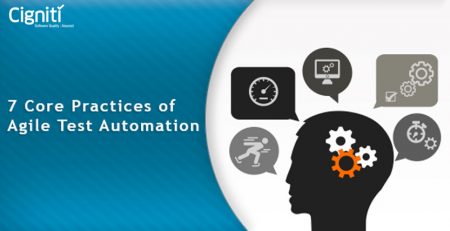6 Ways How Agile Testing Saves IT Enterprises from Testing Inefficiencies
Gartner in its report on ‘10 Things CIOs Need to Know About Agile Development’ states that in the current digital transformation environment CIOs are pressurized to support fast-evolving digital enterprises. However, they find traditional project and development methods ineffective. It has been observed over a period that all old and new enterprises are getting inclined towards Agile development methodology to speed up the projects and bring value.
If executed effectively, agile methods can transform IT-business relationships with a major positive impact on IT value delivery. However, value can be delivered only when the CIOs and the overall IT management teams bring together a culture that supports the success of agile.
Every enterprise, big-medium-small, needs IT support and seamless integration of new functionality for smooth operations. Digital Transformation and Social Media Analytics and Cloud (SMAC) have majorly impacted the way enterprises function and incorporate new ideas within the ecosystem. Start-ups and medium size companies are accepting and getting rid of legacy systems. However, it remains a constant challenge for the big organisations.
Bigger the enterprise, bigger are the challenges and issues at hand. The overall equation involving People-Processes-Technology has to be balanced, which poses a major struggle. The question is, are bigger enterprises technically equipped and sound to take care of these issues? Is there a need to outsource and bring in expertise, and operational efficiency?
Big enterprises are asking this question and outsourcing it to specialists in the industry. But why are we focusing particularly on ‘big enterprises’?
“Big companies, because their problems are bigger, they can’t afford to have sloppy practices,” says Jeff Sutherland, co-inventor of the Scrum Agile development framework and CEO at Scrum Inc. At the same time, he maintains that Agile methodologies can be successfully implemented for enterprises of all sizes. Sutherland further states that “Scrum is a disruptive technology. Applied well, it makes it impossible for your competitors to compete with you.”
According to experts, implementing Agile in big enterprises is more difficult than in smaller systems, where the team sizes are small and it is feasible to organize an ad hoc stand-up meeting, and go back and forth on the decision making. So, it boils down to the same equation mentioned above People-Process-Technology.
Agile Transformation is all about a cultural transformation within an organization’s DNA. It brings some obvious benefits for the enterprise and that’s the very reason large enterprises are considering this shift.
- Agile Testing’s core objective
Technical excellence implies that there is reliability, performance efficiency, accessibility, usability and security within your overall IT system. Meeting technical excellence leads to building technical debt – the gap between what is expected or desired and what is existing or being created right now.
Any enterprise that looks at agile for diminishing the technical debt must consider ruthless realignment in processes and set the objective for adopting a new software development culture. Agile Methodology helps in refactoring and helps eliminate the technical debt, by taking organizations closer to the desired objective.
- Collaborating externally for meeting Agile development demands
Big IT enterprises work and seamlessly collaborate with specialist service providers to outsource application development and leverage their domain expertise. While it has been working for them, there is a constant need to evaluate the mutually decided parameters and business objectives.
It is logical to outsource Agile implementation for software/application development, as a specialist will bring the right formats in place and drive the process for you. However, aspects such as colocation with business users and seamless communication systems have to be taken care of while deciding on the engagement model.
- Impact of Agile transformation
Agile methodologies are adopted to support continuous delivery. There is a constant communication between business managers and users, team members, leads, and delivery teams to constantly streamline new and modified software in the development environment.
This mandates constant coordination and co-working amongst the teams that calls for business governance and relationship management. This nurtures collaborative functioning within teams in spite of distant locations, and is absolutely required while working on projects in the digital ecosystem.
- Responsibility is distributed
As against the traditional flow where testing is done post development, in the agile testing process, the entire team works towards ensuring quality. For instance, in a standard agile team mix, there will be one tester working with two developers.
The developers generally write unit tests while adding more features, and then use them to test the app in the development process. The testers will then continue to write new test cases, build, and test the new code to constantly give feedback to the developers.
- Seamless communication
As you can see, the tester and developer work on the same team and collaborate at every stage. This entails a lot of communication and coordination. So, if a detailed report is required for a bug, it can be accessed immediately without any process issues.
Moreover, regular scrum sessions enable teams to identify defects and resolve them immediately. This results in huge time-cost-effort savings – the key reason why enterprises are shifting towards Agile testing.
- Incorporating new requirements
In a Waterfall method, business requirements are set and planned way in advance. However, with the volatile development scenario and digital challenges, Agile testing approach helps. It is designed to work with uncertain change requests and improvements.
It works on more collaborative working styles, and short sprints with focus on achieving shorter and smaller goals. Every sprint usually involves unplanned features and modifications from the last sprint.
Our take
Cigniti has been a trusted testing partner for many enterprises in their process to adopt Agile, where we have enabled organizations to incorporate agile methodologies in QA planning and testing processes.
In one of such engaging projects, the team collaborated with a leading American multinational information technology corporation providing hardware, software, and services to consumers, SMBs, and large enterprises.
The Client needed Cigniti’s Agile Software Testing expertise to boost its testing efficiency. As observed normally with most mega-sized organizations, the Client was struggling with inconsistent testing processes across the scrum teams and needed high quality deliverables in a rapidly changing Agile environment.
They were working with a limited pool of certified and experienced testing resources. In order to sort this out, Cigniti designed and executed a testing strategy integrated with the Client’s Agile methodology.
The Client was glad with the way Cigniti’s Agile testing experts implemented consistent best practices across scrum teams. They not only provided exhaustive test plans with maintainable supporting artefacts, but also defined regression and automation for expanded test coverage.
This went on to reinforce that even big enterprises need niche expertise from a third party to build efficiency, and leverage specialized resources and ready frameworks.
Additionally, Agile cannot work in isolation and as a solo methodology. There will always be a space for other software development methodologies in your portfolio. During application development, there are a lot of issues to handle. Some issues could be solved with Agile adoption, some issues can be tackled with Waterfall method.
Agile testing, in effect, helps adapt better to some problems and solves it effectively.
Connect with us to adopt Agile methodologies successfully and leverage best practices with third-party expertise.





Leave a Reply